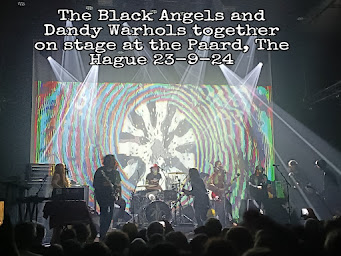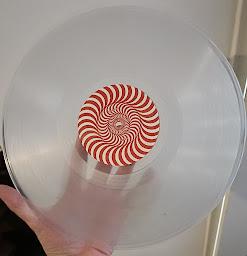Yesterday I was at The Paard van Troje in The Hague, and had a great time at the double bill concert of The Black Angels and Dandy Warhols (plus a short support slot by Miranda Lee Richards). It was a great pairing, as evidenced by the warm reception The Black Angels got by The Dandys' crowd and vice versa, as well as by the two groups' camaraderie and their coexistence onstage during the finale. As for the Black Angels' live performance, it would be fair to say that The Angels are not natural showmen. They reminded me of those 90's shoegaze bands, both with their stage presence and soundwise - albeit with a sixties psychedelic flavor.
The first listen of this record took me by surprise: the opening song wasn't so much reminscent of 60's garage and psychedelia, but rather of the gothic blues of Gun Club. The next track was even slower, like Jim Morrison on barbiturates fronting a similarly medicated Black Sabbath. Then, halfway through, the song graduated from bluesy sludge to Saucerful of Secrets-era Pink Floyd played at the wrong speed - at which point, it dawned on me: Indeed, had been listening to the record at wrong speed. Not only that, I was quite enjoying it, too. So I switched to 45RPM and went at it again: "An Occurrence at 4507 South Third Street" retains that folky element, but the most attention-grabbing element is its frantic organ. "The Executioner" starts off a bit like the middle section of live Doors songs, when the musicians play a vague psychedelic thing as background while the singer lazily adlibs some improvised lyric; then goes into that early Pink Floyd vibe. "Linda's Gone" closes this short EP with some Velvet Underground-inspired drone music. Back on Side 1 proper, "Sunday Evening" is mid-tempo 60's psychedelia with a bright pop chorus, probably influenced by thοse other infamous Austinites, The 13th Floor Elevators. "Tired Eyes" is a catchy fuzzfest more similar to 90's shoegaze, and "Diamond Eyes" another woozy psychedelic tune wrapped in distorted guitars. Closing Side 1, "The Flop" is a frantic piece of garage rock revival with groovy organ a la ? And The Mysterians. By submerging everything in guitar distortion, the band manage to create an atmospheric album, but on the other hand they risk sounding monotonous. Here, its short duration (well under 30 minutes) works to its favor: they employ just enough style variation, hooks, and tempo changes to avoid repetition, but that may not have been possible if the record dragged on. In my opinion, Clear Lake Forest is a good representation of The Black Angels' talents. Nevertheless, it's probably telling that they didn't play a single track from this EP during last night's concert; apparently the band themselves consider it a minor work. On the plus side, it's a gorgeous piece of clear vinyl, with typical for The Black Angels psychedelic design.
**** for Sunday Evening, Tired Eyes, The Flop, An Occurrence at 4507 South Third Street
*** for Diamond Eyes, The Executioner, Linda's Gone








